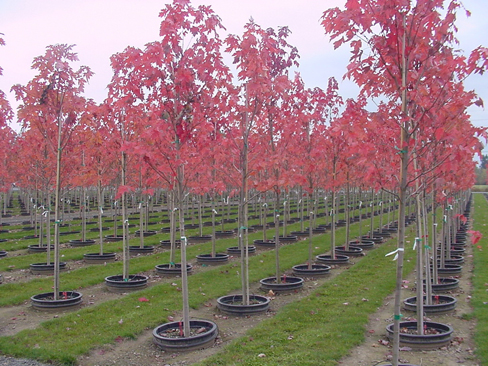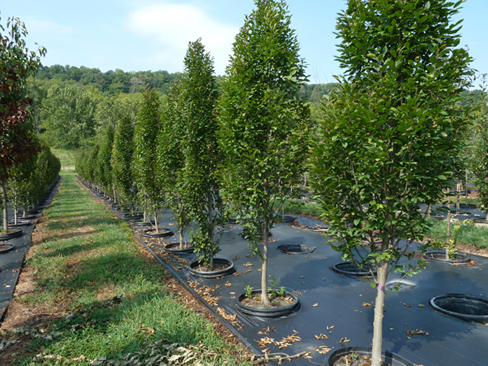Pot-in-pot Nursery Production
“Pot-in-pot” describes a nursery production system that uses containers (production pots) placed inside permanent in-ground containers (socket pots). Pot-in-pot is used for the production of caliper-sized shade trees, flowering trees, and large shrubs. The pot-in-pot system combines many of the benefits of field production with the marketing flexibility of container production. Container-grown plants can be sold at any time of year and with relatively short notice, whereas harvesting of field-grown plants requires more planning and is typically not done during the summer or extremely wet periods. Advantages of pot-in-pot versus above-ground container production include: root protection from extreme hot and cold temperatures, greater pot stability for reduced tipping over, and ability of plants to both grow and overwinter in a single fixed location.
Marketing
 Nursery crops are marketed in several different ways: Retailers market directly to the end consumer, typically homeowners. This is most commonly done either through retail nurseries, which produce some or all of their own plant material, or garden centers, which purchase their inventory from a wholesale nursery. Mail-order nurseries also sell directly to the end consumer, but their plants are shipped directly to the customer rather than sold at a retail outlet. This is a great option for nurseries that produce specialty plants and whose customers are plant enthusiasts located across the country or globe. The vast majority of mail-order nurseries sell either bare root or small container-grown plants (1-gallon containers or smaller) due to high shipping costs and difficulties in packaging, but larger plants can also be sold by mail-order nurseries if they are highly valuable. Wholsalers produce plants that are typically sold in large batches at significantly lower prices to landscapers, retailers, or other nurseries that grow and resell the material at a larger size. Wholesale production is most efficient and profitable when a limited number of plants are grown in large numbers. Re-wholesalers purchase large orders of various plants from wholesale producers and resell the plants to landscapers requiring diverse but smaller orders. Landscape nurseries produce plants for their own in-house landscaping service, but may have a retail outlet as well.
Nursery crops are marketed in several different ways: Retailers market directly to the end consumer, typically homeowners. This is most commonly done either through retail nurseries, which produce some or all of their own plant material, or garden centers, which purchase their inventory from a wholesale nursery. Mail-order nurseries also sell directly to the end consumer, but their plants are shipped directly to the customer rather than sold at a retail outlet. This is a great option for nurseries that produce specialty plants and whose customers are plant enthusiasts located across the country or globe. The vast majority of mail-order nurseries sell either bare root or small container-grown plants (1-gallon containers or smaller) due to high shipping costs and difficulties in packaging, but larger plants can also be sold by mail-order nurseries if they are highly valuable. Wholsalers produce plants that are typically sold in large batches at significantly lower prices to landscapers, retailers, or other nurseries that grow and resell the material at a larger size. Wholesale production is most efficient and profitable when a limited number of plants are grown in large numbers. Re-wholesalers purchase large orders of various plants from wholesale producers and resell the plants to landscapers requiring diverse but smaller orders. Landscape nurseries produce plants for their own in-house landscaping service, but may have a retail outlet as well.
Production
 Internal soil drainage is the primary consideration for pot-in-pot production. Drowning of plants when socket pots fill with water is one of the most common reasons for system failure. Most Kentucky soils do not drain well so a drainage system will need to be installed under the socket pots. A reliable source of clean, pest-free water is another important consideration in selecting a suitable location. The ideal site will have a slightly sloping topography (1 to 2 percent) and offer water drainage to a pond or retention basin for recycling back to the crop. Avoid fields with hardpans and those that could flood periodically. Sites where cold air accumulates (frost pockets) should only be planted with cold hardy species. Installation of socket or in-ground pots requires considerable planning and preparation. The socket pot and production pot need to be compatible units that are manufactured specifically for this purpose. The size of the in-ground pot not only determines the size of the production pot, but also the size of the plants that can be grown.
Internal soil drainage is the primary consideration for pot-in-pot production. Drowning of plants when socket pots fill with water is one of the most common reasons for system failure. Most Kentucky soils do not drain well so a drainage system will need to be installed under the socket pots. A reliable source of clean, pest-free water is another important consideration in selecting a suitable location. The ideal site will have a slightly sloping topography (1 to 2 percent) and offer water drainage to a pond or retention basin for recycling back to the crop. Avoid fields with hardpans and those that could flood periodically. Sites where cold air accumulates (frost pockets) should only be planted with cold hardy species. Installation of socket or in-ground pots requires considerable planning and preparation. The socket pot and production pot need to be compatible units that are manufactured specifically for this purpose. The size of the in-ground pot not only determines the size of the production pot, but also the size of the plants that can be grown.

